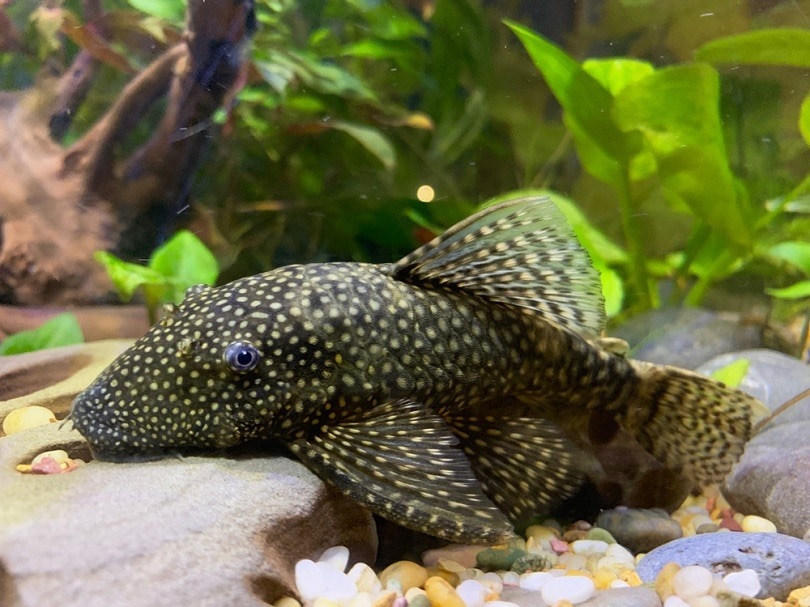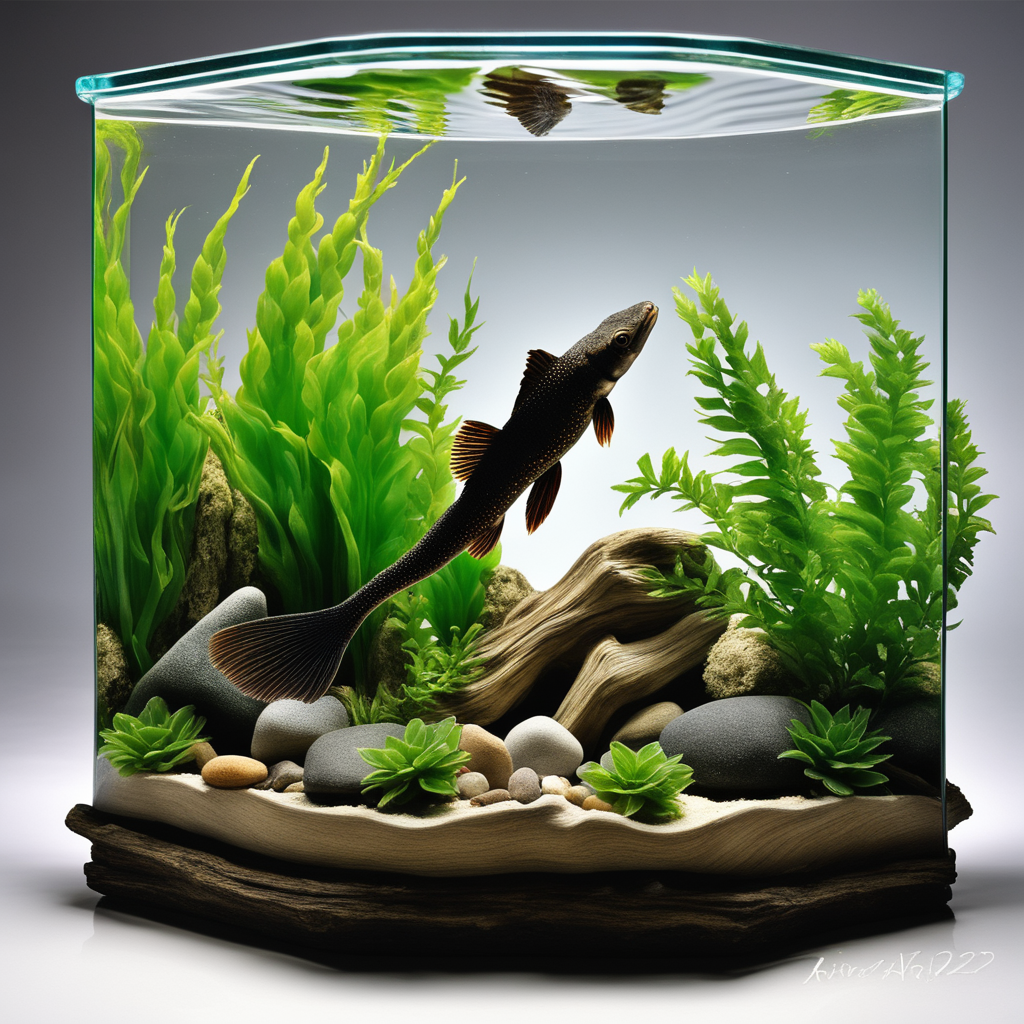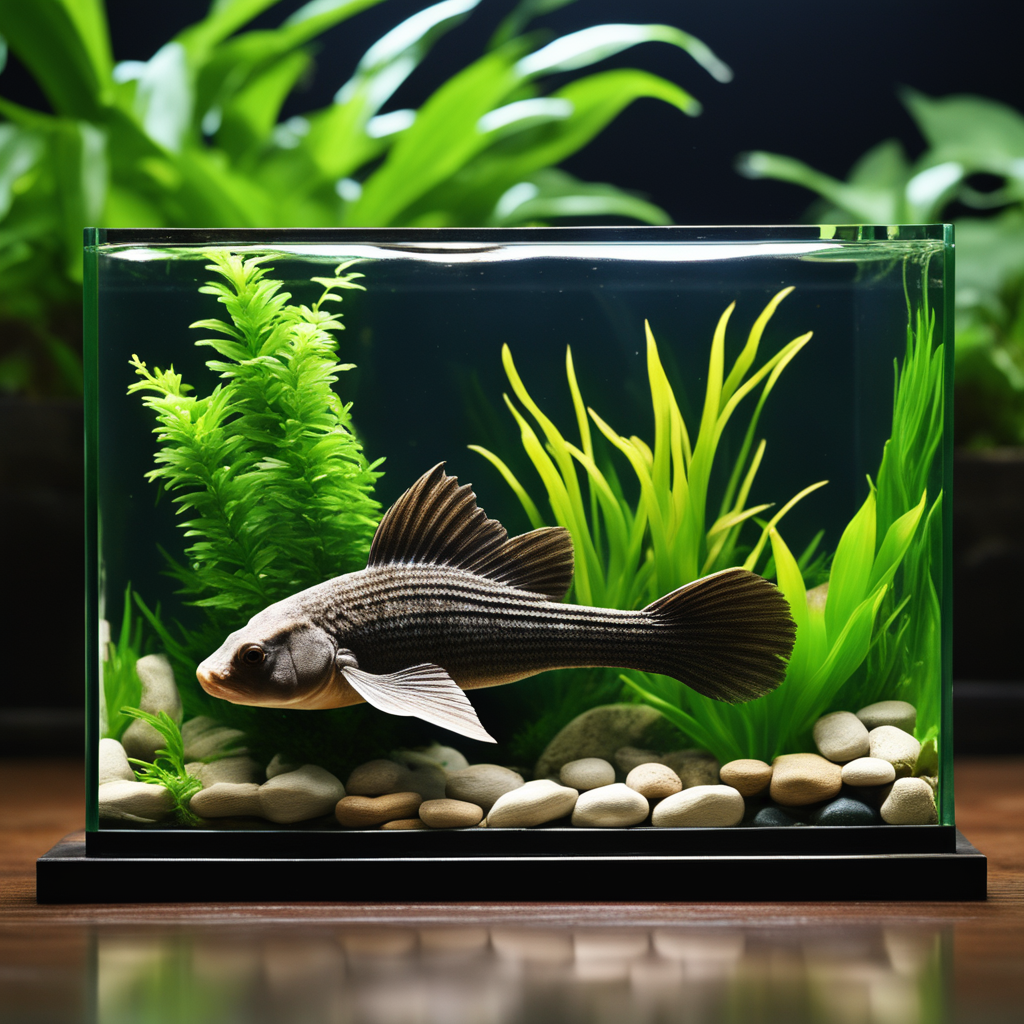Bristlenose Pleco is a type of armored catfish that is native to South America, which you may want to add to your freshwater aquarium.
From tank setup requirements to water quality maintenance, feeding recommendations to breeding tips, we’ve got all the information you need to keep your Bristlenose Pleco happy and healthy.
So, get ready to dive into the world of Bristlenose Plecos and become an expert in their care. Let’s get started!
Here are some quick facts about Bristlenose Pleco:
- Bristlenose Pleco, also known as the Bushy Nose Pleco or Bristlenose Catfish, is one of the smallest catfish species, growing to only 5 inches in length1.
- They have a unique appearance with a flat body, wide head, bony plates, and fleshy tentacles that protrude from their heads4.
- The fish are brown, green, or gray with white or yellow spots, although there are captive-bred solid color variations, including red, orange, lemon, and albino gold4.
- Bristlenose Plecos have a mouth located on the bottom of their bodies, which makes it easier for them to consume algae from the substrate and cling onto vertical surfaces3.
- They are herbivores, primarily feeding on algae in their natural habitat. In an aquarium, feeding them algae or spirulina wafers once or twice daily is recommended1.
- These catfish are peaceful and do well with other peaceful fish in a community tank. They spend most of their time swimming around the bottom of the tank and enjoy hiding in caves and behind plants4.
- Bristlenose Plecos are nocturnal, preferring to do their eating mostly at night1.
- They are undemanding when it comes to water values, but they appreciate a pH that’s on the lower side due to their natural habitat in acidic, soft-water rivers in South America. They also prefer well-aerated water with some sort of current6.

Tank Setup and Size Requirements
To ensure a healthy and comfortable environment for your bristlenose pleco, your tank should be adequately sized and set up properly. Bristlenose plecos are relatively small fish, but they still require a tank of at least 20 gallons. A larger tank is always better, as it provides more swimming space and helps maintain better water quality.
These fishes are relatively small catfishes which reach a size of between 4 to 6 inches.
To choose correct tank size for pleco, you can use a simple formula:
2 galloons per inch of fish.
So, if a bristlenose is 5 inches (average), for a pair of (female and male) fish you need a 20 galloons of tank. for a 55 galloons tank, not more than 5 bristlenoses should be kept.
When setting up the tank, it’s important to include plenty of aquarium decorations, such as caves, driftwood, and plants. These decorations not only provide hiding spots for the pleco but also mimic their natural habitat.
As for tank mates, bristlenose plecos are generally peaceful and can be housed with other peaceful fish species, such as tetras, guppies, and rasboras. However, it’s best to avoid aggressive or fin-nipping species that may harm the pleco.

What are good Tank Mates for Bristlenose Pleco?
Bristlenose Plecos are generally peaceful and can usually coexist with a variety of tank mates. Here are some good options for tank mates for Bristlenose Plecos:
- Community fish: Many community fish, such as tetras, guppies, mollies, swordtails, and rasboras can live peacefully with Bristlenose Plecos.
- Gouramis: Dwarf Gouramis or other smaller species of Gouramis can make good tank mates.
- Corydoras Catfish: These bottom-dwelling catfish species are similar in size and behavior to the Bristlenose Pleco and can make excellent companions.
- Small peaceful cichlids: Some small cichlid species like German Blue Rams or Apistogrammas can be compatible tank mates if the tank is large enough.
- Other small peaceful bottom-dwelling fish: Fish such as Kuhli loaches or Otocinclus catfish can also coexist harmoniously with Bristlenose Plecos.
Add plecos to the tank before bettas, so they can establish their territories first.
It is always recommended to research individual species’ compatibility before adding them to your aquarium to ensure they have similar care requirements and temperaments.
Ideal Water Parameters for Bristlenose Pleco
Maintaining proper water parameters and quality is essential for the health and well-being of your bristlenose plecos. To ensure the best conditions for your beloved fish, here are some key points to consider:
- Regular water testing: It’s crucial to regularly test the water parameters such as pH, ammonia, nitrite, and nitrate levels. This will help you identify any issues and take corrective measures promptly.
- Filtration options: A reliable filtration system is vital to keep the water clean and free from harmful toxins. Consider using a combination of mechanical, biological, and chemical filtration to effectively remove debris, break down waste, and eliminate harmful substances.
- Beneficial bacteria: Promote the growth of beneficial bacteria in your tank to aid in the natural filtration process. This can be achieved by using products like biological filter media or adding live plants to your aquarium.
Ideal water parameters for Bristlenose Plecos are:
- Temperature: 72-82°F (22-28°C)
- pH: 6.5-7.5 (slightly acidic to neutral)
- Hardness: Moderate to hard water, around 5-20 dGH
- Ammonia and nitrite levels should be kept at zero.
- Nitrate levels should be below 40 ppm, ideally closer to 20 ppm or less.
It is important to maintain good water quality by performing regular water changes and using a reliable filtration system in the tank. Bristlenose plecos produce a significant amount of waste, so proper filtration is crucial.
Additionally, while bristlenose plecos can tolerate a wide range of water conditions, sudden changes in temperature, pH, or other parameters can stress them out and potentially lead to health issues. It is recommended to acclimate them gradually if there is a need to change their environment.
Monitoring the water parameters regularly using test kits will help ensure that the conditions are appropriate for your Bristlenose Pleco’s health and well-being.
What to Feed Bristlenose Pleco
Feeding your plecos a balanced diet rich in vegetables and algae is important for their overall health and nutrition. Plecos are herbivores and their diet should mainly consist of plant-based foods. Here is a table that provides you with some examples of suitable foods to include in your plecos’ diet:
| Vegetables | Algae | Supplements |
|---|---|---|
| Zucchini | Spirulina | Calcium |
| Cucumber | Nori | Multivitamin |
| Spinach | Chlorella | Mineral blocks |
| Kale | Blanched lettuce | |
| Broccoli | Algae wafers |
To ensure your plecos receive a well-rounded diet, it is recommended to offer a variety of vegetables and algae. You can rotate the types of vegetables and algae to provide different nutrients. Additionally, consider using feeding techniques such as attaching vegetables to a feeding clip or sinking the food to the bottom of the tank. It is essential to establish a regular feeding schedule to maintain their health and prevent overfeeding.
One thing to remember is, these fishes are noctrunal. This means you should feed the fish before you turn off the tank lights.
These fishes are algae eaters. THey consume various types of algae, including green and brown algae, which makes it a popular choice for aquariums that require natural algae control

Health and Disease Prevention
This tropical fish has a reasonably long lifespan when provided with proper care and suitable tank conditions. On average, they can live for around 5 to 10 years in captivity. However, some individuals have been known to live even longer, reaching up to 15 years or more under ideal circumstances.
To keep your plecos healthy and prevent diseases, it’s important to monitor the water quality and maintain a clean and well-filtered tank. Here are some tips to help you maintain the health of your plecos:
- Regular water testing: Monitor the ammonia, nitrite, and nitrate levels in your tank to ensure they’re within the acceptable range for plecos.
- Frequent water changes: Regularly change a portion of the tank water to remove any accumulated toxins and maintain optimal water quality.
- Quarantine new fish: Before introducing new plecos to your tank, quarantine them for a few weeks to prevent the spread of common diseases.
Breeding and Reproduction Tips
Bristlenose plecos are one of the easiet species to breed.
| female albino bristlenose pleco |
Start by selecting a spacious tank with a minimum capacity of 20 gallons. Place caves, driftwood, or PVC pipes in the tank to create hiding spots for the plecos. These hiding places not only provide shelter but also serve as potential breeding sites.
Maintain a stable water temperature between 75-82°F and pH levels around 6.5-7.5. Adequate filtration and regular water changes are crucial for maintaining optimal water quality.
Be sure that there is a compatibility with brislenoses. This means thre should be one male and one female bristlenoses should be paired.
When introducing a pair of plecos, make sure they’re mature and well-fed. Provide a balanced diet of vegetables, algae wafers, and occasional protein-rich foods.
Water temp should be slightly cooler than usual tank temperature to replicate natural enviroment for breeding.
Once the female has selected a suitable cave, she will lay adhesive eggs inside it while the male fertilizes them by releasing milt over them during courtship displays.
Incubation Period:
After spawning, the eggs typically hatch within about a week while remaining attached to surfaces like caves or driftwood.Fry are usually free-swimming after another week or so.
With a well-designed breeding tank setup, you can overcome breeding challenges and increase the likelihood of successful pleco reproduction.
Conclusion
In conclusion, providing proper care for your bristlenose pleco is essential to their overall health and well-being. By ensuring the right tank setup, maintaining optimal water parameters, offering a varied and nutritious diet, and taking preventive measures against diseases, you can create a thriving environment for your plecos.
With the right knowledge and attention, you can also have success in breeding and reproduction. Remember to always stay informed and educated to provide the best care for your beloved bristlenose plecos.

